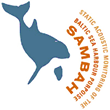The data collected through the EU Life+-funded Static Acoustic Monitoring of the Baltic Sea Harbour Porpoise (SAMBAH) project shows for the first time a clear distinction between the population of porpoises inhabiting the Baltic Proper and the population in the Western Baltic, Belt Seas and Kattegat area during the months important for reproduction.
 16 December 2014: The data collected through the EU Life+-funded Static Acoustic Monitoring of the Baltic Sea Harbour Porpoise (SAMBAH) project shows for the first time a clear distinction between the population of porpoises inhabiting the Baltic Proper and the population in the Western Baltic, Belt Seas and Kattegat area during the months important for reproduction.
16 December 2014: The data collected through the EU Life+-funded Static Acoustic Monitoring of the Baltic Sea Harbour Porpoise (SAMBAH) project shows for the first time a clear distinction between the population of porpoises inhabiting the Baltic Proper and the population in the Western Baltic, Belt Seas and Kattegat area during the months important for reproduction.
The data, collected through passive acoustic monitoring over a two-year period, show that during the summer breeding season the Baltic population concentrated mainly around the Midsjö offshore banks southeast of Öland, Sweden, yet during the winter months the animals seem to be more widely dispersed, moving both east further into the Baltic Sea and west into German, southern Swedish and Danish waters.
The Convention on the Conservation of Migratory Species of Wild Animals (CMS) notes that this “newly released information will be of crucial importance for national entities entrusted with the conservation of marine life in their waters, as well as for international bodies working in the region, such as HELCOM (Helsinki Commission) and, of course, ASCOBANS (Agreement on the Conservation of Small Cetaceans in the Baltic, North East Atlantic, Irish and North Seas).”
CMS highlights that the ASCOBANS Recovery Plan for Baltic Harbour Porpoises (Jastarnia Plan) can “now be reviewed and revised based on these new findings.” [CMS News] [SAMBAH website]